5
Fitting Materials, Engineering, and Configuration
After the fixture materials have been selected, designers turn their attention to selecting the corresponding fittings. These water-delivering devices are called different names in different parts of the world and by different professionals in the construction and design community. Consumers in North America typically think of them as faucets and drains. Plumbing professionals might refer to them as trim or the rough-in valve or simply brass. The term “tap” is used in other parts of the world for any everyday type of valve, particularly the fittings that control water supply to bathtubs and sinks. It is the use of the word “tap” that has led to the term “tap water” as the standard name for water from a faucet.
Designers should always use terms their clients are accustomed to; therefore, in professional discussions, these fittings may be referred to as faucets, taps, or fittings.
This chapter discusses the base construction materials used to fabricate water-delivering fittings and describes the various finishes available for the designer’s specification.
- Learning Objective 1: Describe the differences in construction materials and finish options as well as various configurations available for kitchen and bathroom faucets.
- Learning Objective 2: Explain the differences among manual, sensor, and electromagnetic contact faucet controls.
- Learning Objective 3: Categorize the various configurations of kitchen and bathroom faucets.
- Learning Objective 4: Provide a comprehensive list of operational attachments available for kitchen sink and bathroom lavatory areas.
- Learning Objective 5: Explain how fitting design impacts the temperature and volume controls of the faucetry.
The fittings available today have expanded from a single handle used to deliver cold or hot water, to mixing valves that deliver temperature-controlled water, to new fittings activated by a sensor system or electromagnetic touch technology. The differences in these new technologies are discussed.
There is a wide variety of faucet configurations as well as numerous functional attachments that are either required or can enhance the water delivery system. These options are detailed in this chapter as well.
This chapter also covers water control that is part of well-engineered fitting design, as it relates to establishing a variable comfort zone, controlling the volume of the water, and controlling the water temperature.
CONSTRUCTION MATERIALS
Brass
Brass is considered an excellent material for faucet construction because it is a strong, durable metal virtually unaffected by prolonged contact with water. Brass is an alloy of copper and zinc, with trace materials, such as lead, that improve machining or silicon to improve casting. It varies in color from yellow to red, and can be melted and poured into molds or machined from stock or rods.
Brass faucet bodies may be sand cast, much like a cast iron bathtub. Faucet component parts manufactured this way tend to have the lowest density and can be porous, which can cause pinholes and leaks. Because sand molds cool the brass quickly, this type of brass faucet must have the highest lead content.
Gravity die-casting is another way that brass faucets are manufactured. Molten brass is poured manually or injected automatically into a machined metal form. Waterways and other hollows are either machined or formed with a sand core. This method of casting provides greater density than sand casting but still must be inspected at the factory for pinhole leaks.
Forging is another method of forming faucet bodies from brass. In the forging process, a heated brass plug is pressed by extremely high pressure between two machined metal forms, which produces a smooth component part that requires little polishing. Waterways and other hollows are formed through machining. This process results in a fitting with few surface imperfections and a high-quality surface luster.
Last, brass stock, bars, rods, tubing, or thin sheets can be machined or cold stamped into desired forms and shapes. Again, minimal polishing is required, and low-lead-content brass can be used.
No matter what manufacturing process is used, brass provides a durable, long-lasting faucet material that stands up well. Even if the finish is damaged, the brass underneath holds up to heavy use. Because it is a costly raw material and involves complicated manufacturing processes, brass fittings are more expensive than fittings fabricated from plastic materials.
Copper
Copper is used for waterways of fabricated fittings and in some valve connections. Because it is softer than brass, copper can be shaped and bent easily. If uncoated, copper is prone to surface corrosion and scratching.
Plastics
Plastics—acrylonitrile butadiene styrene (ABS), acetal, chlorinated polyvinyl chloride (CPVC), and rubber—are smooth, relatively soft materials commonly used in valve systems and cartridges or the gasket material under the fitting. Some extremely low cost fittings feature plastic bodies or waterways. Plastic materials are inexpensive and not prone to a lime or scale buildup. The smooth, slippery surfaces ease the passage of water and debris, as opposed to rougher surfaces that can catch or slow such material.
Plastic valves can be damaged by line debris, such as sand and silt. Unless the plastic receives special preparation or is of plating grade, it is not as durable or strong as other materials, and it is difficult to plate with special finishes. Additionally, it can be attacked by certain petroleum-based products.
Color matching plastic components to other components made from metal can be difficult due to the differences in texture, gloss, and light reflection.
Stainless Steel
Stainless steel does not need the additional finish that brass faucets do. Stainless steel faucets stand up well to high pressure, high temperatures, and potentially corrosive materials in the water supply. Stainless steel is more difficult to work with than brass, though, and is more expensive.
Zinc
Zinc is a silvery-white metal that is cast into forms and shapes. It is stronger and more durable than some plastics and smoother than brass. Therefore, it requires less polishing and buffing for a finished product. Zinc must be fully protected from contact with water by plating because it quickly corrodes and disintegrates if unprotected pieces come in contact with water.
PLANNING CONSIDERATIONS WHEN COMBINING FINISHES
Over the last several years, there has been a dramatic increase in technical innovations and finishing options available to the designer. While chrome finishes still predominate, modern faucets can be finished in nickel, brass, colored plastics/epoxy, stainless steel, gold, and living hand-rubbed finishes.
Many manufacturers offer a complete line of kitchen and bathroom faucet sets and coordinating accessories. These accessory items include towel bars, grab bars, and other accessories to match faucet offerings. Occasionally, a client will select specialized equipment that is not part of a full line product offering. Or a client may like one manufacturer’s decorative bathtub faucet set and another company’s accessories. Although various finishes will blend, if the client is expecting a perfect match, only one manufacturer’s suite of products should be specified.
This problem is magnified if the client wants the colored fittings to match fixtures, wet walls, and counter surfaces made from other materials. For example, a client may expect the white epoxy-coated faucets to match the white solid surface countertop and the white acrylic shower stall. Because of the fixture and surfacing material composition differences, a match cannot be promised. Remember, a bathroom lavatory is china or enamel, the faucets have an epoxy coating, the wet walls/countertop solid surfacing is a blend of polyesters and acrylics, and the bathtub enclosure is an acrylic fixture. Talk to the client about colors blending with one another, not matching.
To overcome this color match dilemma, consider these solutions:
- Try to use only one surfacing material throughout the project. For example, in a bathroom, use solid surface materials in the shower and on the vanity top or ceramic tile on all surfaces.
- If your firm has a showroom, create a display setting that is all white. Make sure the whites on the floor, fixture, counter, walls, and fittings blend but do not match. This will give you a chance to explain the color variation to a client before the final project specifications are completed.
- Specify fittings that have a colored, chrome, or brass escutcheon plate separating them from the counter or wall. Such a color break will help camouflage slight differences in color tones.
Fitting Finishing Options
Chrome
Polished chrome. Polished chrome is the most popular finish for kitchen and bathroom fittings and hardware. It is extremely hard and does not oxidize in the air as do most other metals, thereby eliminating the need for regular polishing. Chrome is electrochemically deposited over the nickel-plated base metal. The nickel provides luster, brilliance, and corrosion prevention, while the chrome contributes color and tarnish resistance. It is a very bright and durable finish.
Brushed and matte chrome. A brushed finish is created by using a wire wheel to score the surface of the component part. This can result in a surface with sharp peaks and valleys that do not take the chrome finish quite as well during the plating process because the coating shears away from the peaks and accumulates in the valleys.
A matte finish produces a similar appearance without producing noticeable brush marks or the sharp peaks that are difficult for plating. This process is similar to sand blasting the components with fine glass beads to create a soft matted surface that plates better, to produce a finish as durable as polished chrome.
Nickel
Polished and brushed nickel finishes are popular. This finish is produced by a plating process called physical vapor deposition (PVD). Several other finishes also are applied with the PVD process.
PVD Finishes
Popular nickel, gold, bronze, and brass finishes today are created through a process developed by NASA called physical vapor deposition, referred to as PVD. These finishes are durable and designed not to corrode, tarnish, or discolor. The process embeds molecules deep into the faucet’s surface, creating a strong, indestructible bond.
Differences in the alloys in the vapor deposited on the faucet yield different color finishes. Popular finishes today are:
- Brushed nickel and polished nickel
- Brushed brass and polished brass
- Brushed bronze, dark
- Brushed bronze, medium
- Polished gold
Figure 5.1 shows a bathroom faucet in several faucet finishes popular today. Figure 5.2 includes examples of popular kitchen faucet finishes.
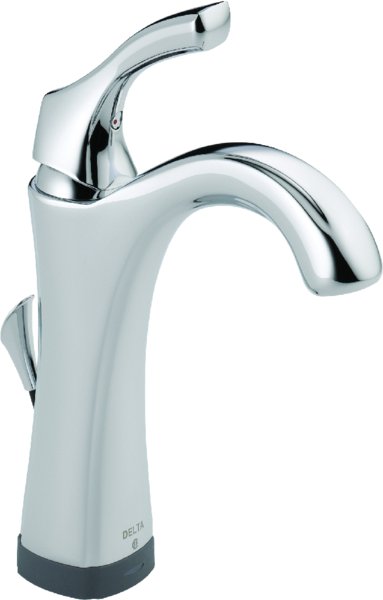
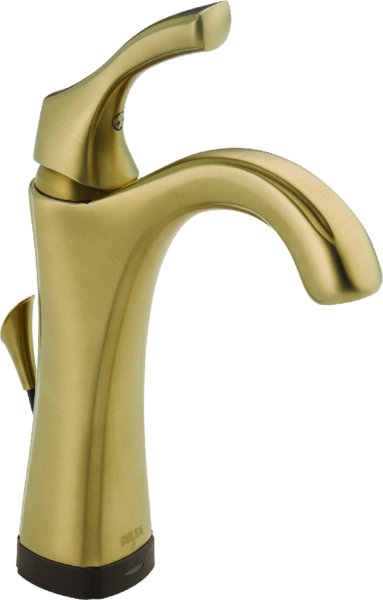
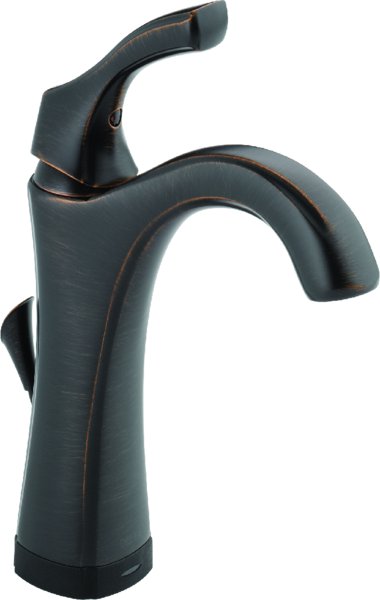
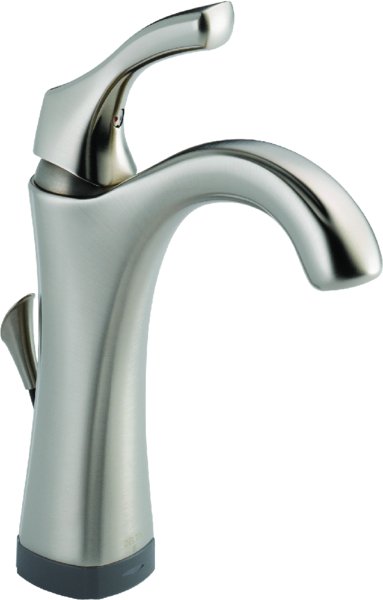
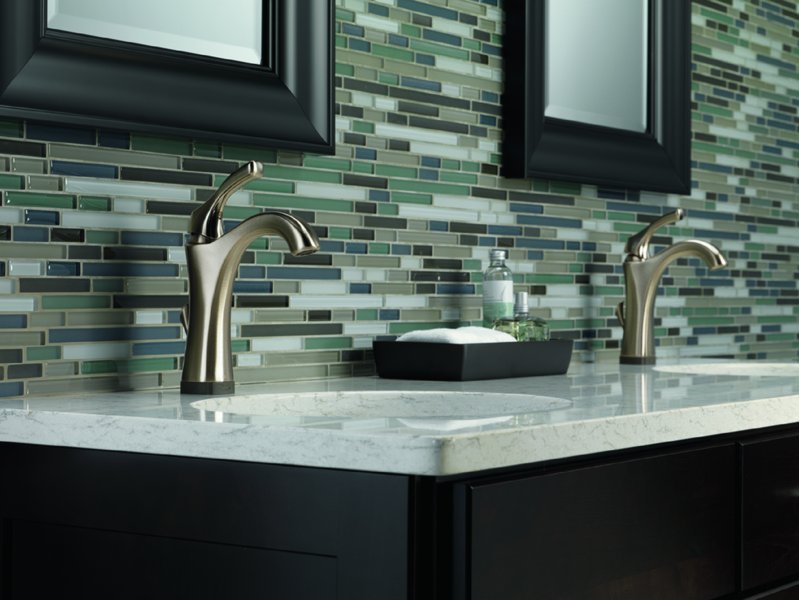
FIGURE 5.1 Popular bathroom faucet finishes
Courtesy of Delta Faucet Company
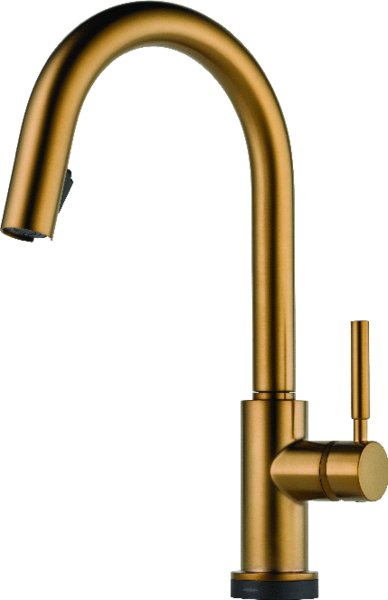
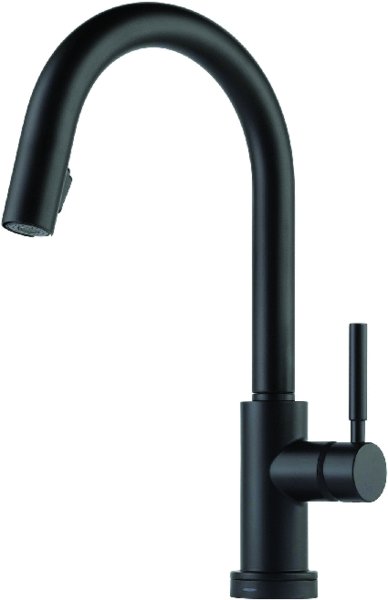
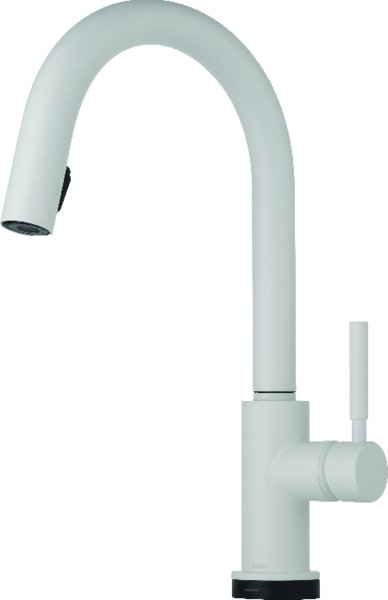
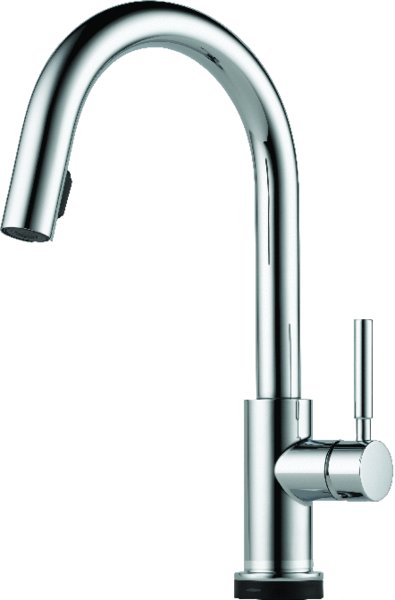
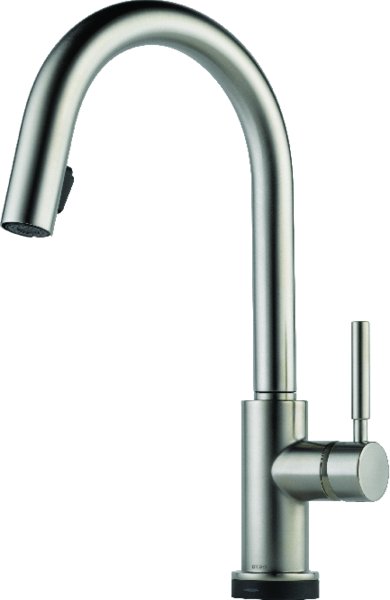
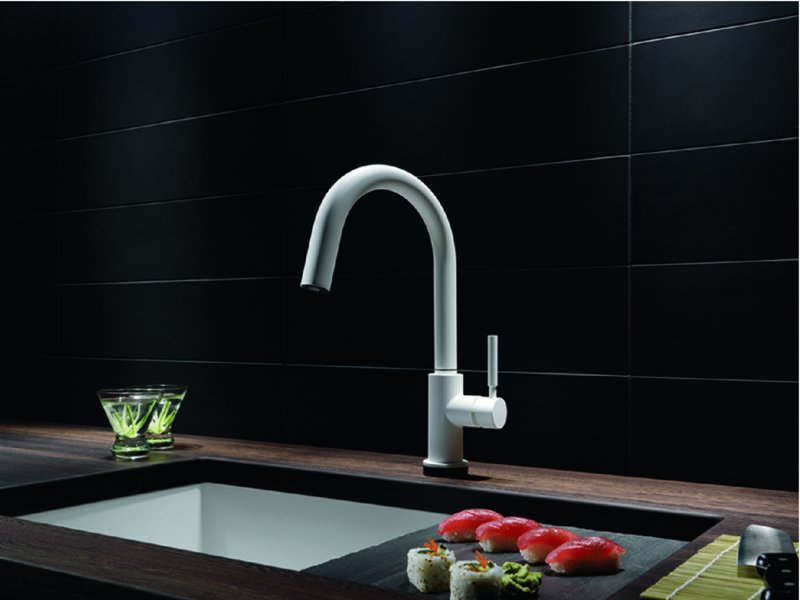
FIGURE 5.2 Popular kitchen faucet finishes
Courtesy of BRIZO
Stainless Steel
Some manufacturers offer faucets made from solid stainless steel. Stainless steel does not stain, corrode, or rust as easily as ordinary steel.
Polished and Satin Gold Plate
For polished and satin gold plate, the highly polished brass product is first nickel plated, and then 24-karat gold is applied. Durability depends on the thickness of the gold layer. According to industry standards, plating to a thickness of less than 7 millionths of inch gold is gold wash or gold flash. Between 8 and 12 millionths is gold plating, and from 13 to 50 millionths is heavy gold plating.
All quality gold-plated fittings should fall into the latter category. Low-quality gold wash or gold flash is not durable and can wear after only three to six months of normal handling. It is very difficult to visually distinguish between high- and low-quality gold plate. Therefore, design professionals should review specific product specifications before recommending a gold-plated fixture.
Gold plate is available in either a polished or a satin finish. Given a quality plating job, both finishes provide good durability.
Quality gold will not tarnish. Maintenance of a satin gold finish is somewhat easier than polished gold because it hides marks better. The secret to long-lasting gold plate is to clean it only with a soft, damp cloth. Never expose gold plate to abrasives or acids as can be found in many commercial cleaners.
Colored Coatings
A tinted epoxy coating is used to create a colored finish. The powder is sprinkled on (or a liquid is sprayed on) to the components and then baked at temperatures ranging from 375° F to 425° F (190° C–218° C) to provide thorough, even coverage and protection.
The coating can be scratched by mild abrasives, which results in an unattractive finish. The key is to clean and dry the faucet frequently after use to avoid the need for heavy cleaning and to never use an abrasive cleaner.
Living Finishes
Oil-rubbed bronze, weathered copper, and real brass are popular in rusticated environments. These finishes change with age. They are not coated in any way, and the finish is not expected to remain constant. They take continual care and cleaning. The copper sink shown in Figure 5.3 is an example of a living finish.
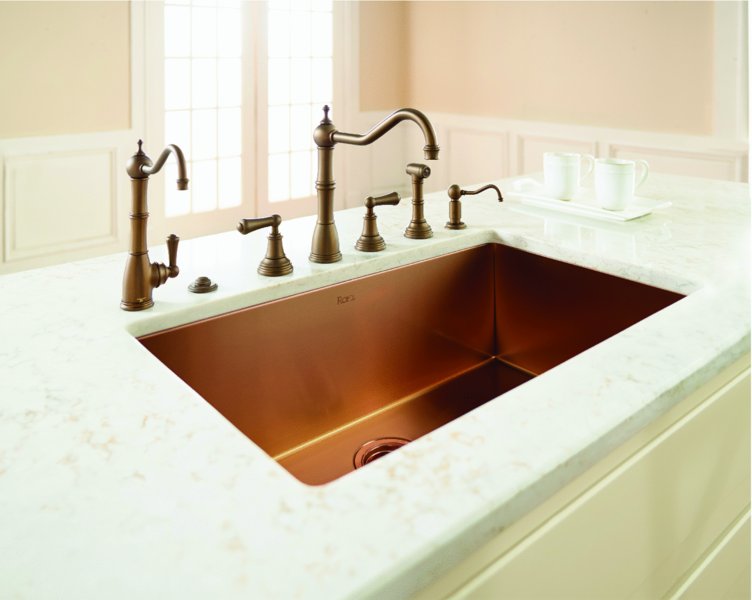
FIGURE 5.3 Living finish faucet: When a decorative finish is specified for the fittings, all sink accessories must be purchased from the same manufacturer to provide finish continuity.
Courtesy of ROHL
Rustic Finishes
Rustic finishes, such as pewter, copper, bronze, just to name a few, are available. These special finishes typically are used for bathroom vanities. Finish application methods vary by manufacturer; therefore, designers should consult with a plumbing product expert to learn how these faucets are finished.
KITCHEN AND BATHROOM FAUCET FITTING ENGINEERING
At the turn of the twentieth century, indoor plumbing systems brought water to the taps—one for hot water and one for cold water. The kitchen sink or bathroom lavatory was a bowl with a stopper at the bottom, to allow the user to fill the bowl with hot and cold water mixed from these two separate taps. It is not uncommon to see this type of system still in use around the world, notably in bathrooms.
In North America, hot and cold water is channeled through a mixing faucet, or common outlet or spout. The hot and cold water is regulated by adjusting two separate handles or by turning/pulling/pushing a single handle. Various manufacturers have proprietary methods of mixing water and specific materials within the design’s internal mechanism of the faucet. Designers should familiarize themselves with specific product engineering features and benefits.
Fitting Activation Systems
Faucets can be operated by manually lifting, twisting, or turning handles. New hands-free technology is available. Two primary activation systems are available:
- Sensing technologies
- Electromagnetic technologies
Sensing (Touchless) Technologies
Sensing technologies have been used in public restroom lavatory faucets for a long time. These commercial faucets deliver water at a certain temperature and volume and are activated when the user’s hands are placed underneath the spout or as the user approaches the lavatory. This type of operation also is available in residential bathrooms and kitchens. These faucets are battery operated and must be installed exactly as outlined in the manufacturer’s installation instructions.
For kitchen faucets, the sensor may be on the top of the spout, underneath the spout on its arched area, or closer to the face of the spout. The user can wave a hand or an object, such as a pan or kitchen utensil, to turn the sensor on.
When investigating such hands-free sensing technology, designers should review product specifications to understand how the product can sense the user’s existence, regardless of external factors, such as light reflection, clothing color, and textures or dryness of a person’s skin. Some infrared technology works on intensity of light, which may detect outside influences, causing the faucet to activate unnecessarily. The best-designed sensing technologies provide consistent, dependable responsiveness of the faucets.
Electromagnetic (Touch) Technologies
Touch control faucets are activated when the human body meets any part of the spout or handle (see Figure 5.4) of the faucet when it is in an open position. The contact creates an electromagnetic pulse that sends a signal to the solenoid-activated valve installed underneath the sink along the faucet piping. Much like the touchless sensing faucet, it is powered by a battery pack. These faucets can tell the difference between a touch and a push. Manual operation is always available.
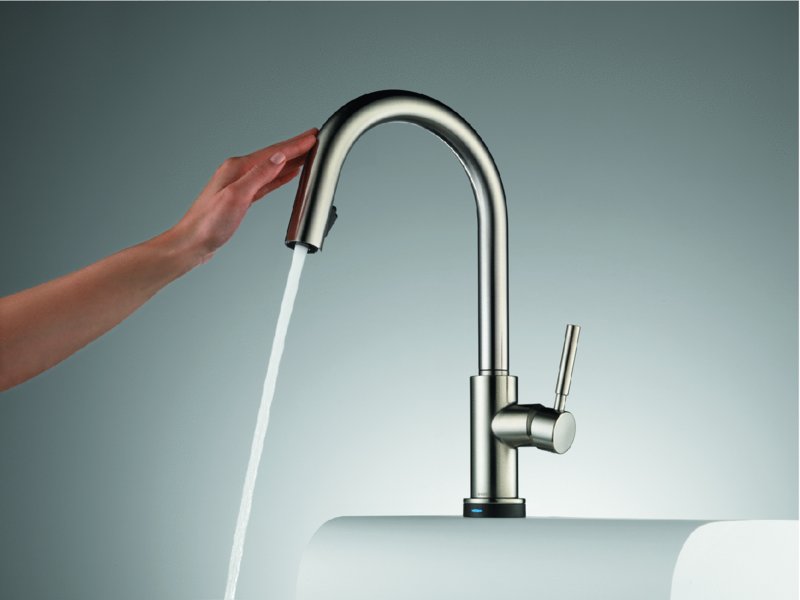
FIGURE 5.4 Touch control faucet
Courtesy of BRIZO
Both touch and sensing touchless faucets are controlled by the solenoid valve that is part of the faucet assembly. The diaphragm of the solenoid valve uses a rubberlike disk to control water flow. The valve is normally held closed. Then, in response to the sensor’s signal that something is present or to a tap by the user, the solenoid pulls the valve open so water can flow out the spout. It pushes the valve closed again when the sensor indicates the object is gone or when the faucet is tapped a second time.
As noted, it is critical that the manufacturer’s installation instructions be followed exactly as detailed. The solenoid must be protected from contact with any other metal or in some cases in a sight line of metals. The installation instructions will give directions on the exact location of the battery box as well as the proper directional focus of the solenoid itself.
This is important technical information for the design professional to know. In the event a client calls complaining that an electronic faucet is not working, the first three checks to be made are:
- Was the faucet installed according to the installation instructions?
- Has the solenoid been accidentally moved or reoriented?
- Is it time to replace the batteries?
Faucet Engineering
The performance of a faucet over its years of use is determined by the way it is engineered to control all aspects of water. In addition to understanding the design of the faucet, the professional kitchen and bathroom design specialist must understand how faucets operate. All faucets feature either a washer or a washerless design. Each manufacturer has detailed training material available to introduce you to its range of choices.
Water Control Considerations
Comfort Zone
Human beings are comfortable using water that ranges from 95° F to 105° F (35° C–40.5° C). The distance of the fitting swing within this comfort zone determines how much adjustability is offered to the user. The total distance of travel from cold to hot should be as great as possible. A handle with a 120-degree arc from the hottest setting to the coldest and with a 40-degree arc within the comfort zone from 95° F to 105° F (35° C–40.5° C) is a functional, safe fitting design.
Volume Control
Most single-handle faucets have a 15-degree lift from the off to the fully on position. Some faucets offer a 20-degree lift. This lift range starts with the valve in a closed position. At the top of the scale, the valve is completely open. The ideal faucet design allows the water flow rate to be increased gradually as the faucet valve is opened with a lift/twist/turn action. The water flow should begin at 1 degree off the lift and continue in a gradual increase that is in proportion with the degree of movement. This type of fine-tuning offers the user a faucet that is safe and easy to use. Unfortunately, some single-handle faucet designs do not allow the water flow to begin until the faucet reaches approximately 7 degrees of the movement. With this type of fitting, the user’s range of control is dramatically decreased.
Thermostatic Water Temperature Controls
Temperature control technology is available today that senses the water temperature before it leaves the faucet spout. For some faucet designs, an LED light changes color to let the user know exactly when water has reached the desired temperature or if it is considered hot or cold. These new technologies provide a constant temperature (± 3–5 degrees) no matter what other water demands occur in the rest of the home. There will be no sudden (and unwelcome) increases or decreases in water temperature while using the faucet. Chapter 6 (see the section titled “Scald Protection Devices” under “Shower Fittings”) includes more detailed information about temperature-controlling valves.
Kitchen Faucet Configurations
The kitchen faucet configuration is determined by the position and number of controls, the faucet location relative to the sink, and the inclusion of any special features such as special-purpose spray heads.
Number of holes required by the faucet:
- Single-hole faucet. A single handle control requires only one hole in the countertop. The water filler and the control mechanism are designed to function within this one-hole configuration. Its snout may or may not swivel.
- Two-hole faucet. The water spout occupies one hole, and the single water volume/temperature control occupies the second hole in the countertop.
- Three-hole faucet. The hot and cold handles are separate from the spout and require three holes. A variation of this theme is called a bridge faucet, which has a horizontal connector (bridge) joining hot and cold water sources, as seen in Figure 5.5. The bridge is a prominent design feature above the countertop or the deck.
Location of faucet (next to or behind the sink):
- Wall mounted. Faucets that are mounted on the wall behind a sink need to be located carefully so that they are properly placed above the kitchen sink and have a spout length specified so the water is deposited in the center of the kitchen sink.
-
Special-purpose wall-mounted faucet (pot filler). These are typically wall-mounted, jointed faucets behind the range so that pots can be filled on the range top (see Figure 5.6). There are also deck-mounted pot filler faucets. Utilizing a pot filler without a sink does not provide the cook a nearby option to dispose of used water. Therefore, many designers combine a pot filler faucet or a pull-down/pull-out faucet with a small sink next to the range. Figure 5.7 shows a pot filler faucet with a sink alongside the stove.
Special-purpose spray heads:
- Pullout and pull-down. A hose or spray head emerges from the faucet spout, and the combination pulls down or out, increasing the faucet’s reach. A button, lever, or toggle changes the water stream to a spray. How the spray head seats itself back into the main water spout is important to know: Better-engineered faucets have a magnet system. These systems securely hold the spray wand in place when not in use.
- Pro style. These sprays are oversize, large-scale pull-down faucets that bring a restaurant look into a residence. Typically they have a long hose or an elongated gooseneck with a spray head that offers choices of spray heights (see Figure 5.8). The oversize faucet may need to have a support bar holding it in place to the countertop or wall to provide rigidity.
- Pivot. The pivot faucet serves work centers opposite one another, as seen in Figure 5.9.
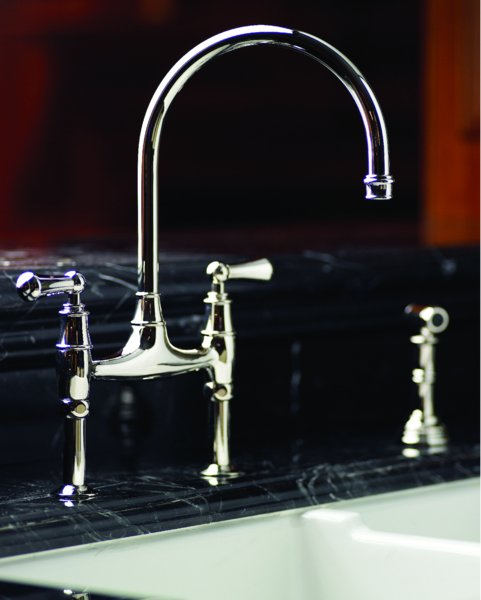
FIGURE 5.5 Bridge faucet
Courtesy of ROHL
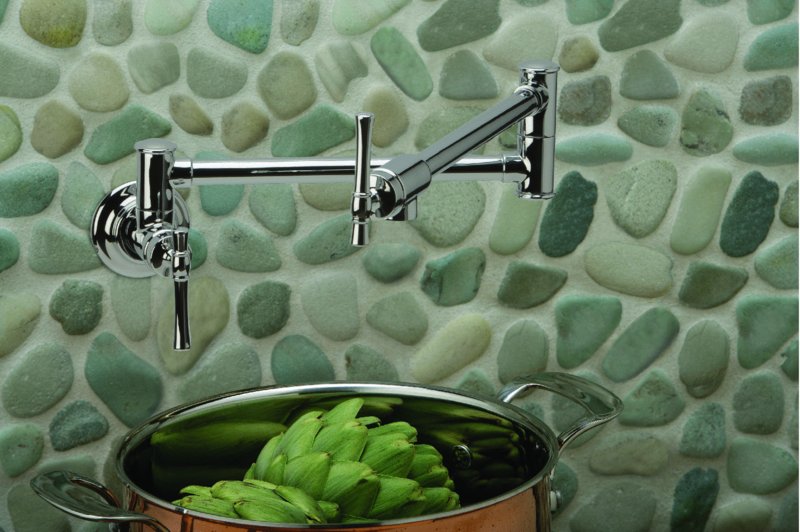
FIGURE 5.6 Pot filler water source
Courtesy of Elkay Manufacturing Company
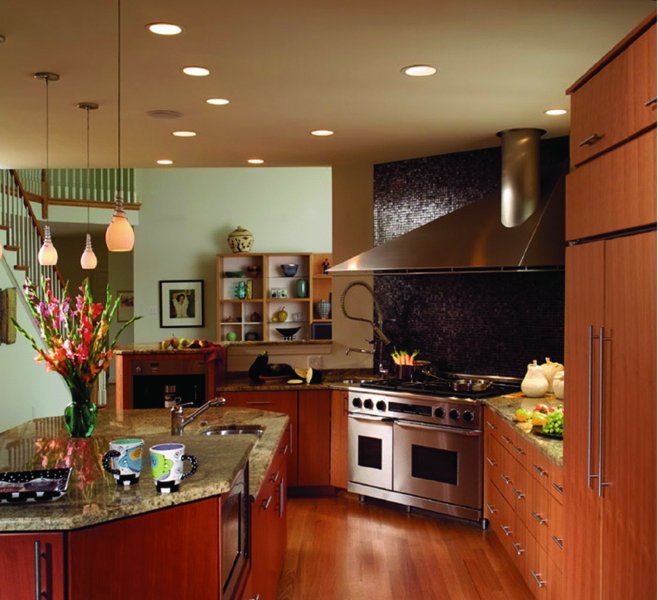
FIGURE 5.7 A sink and faucet placed adjacent to the cooking surface provide a faucet to be used as a pot filler as well as a sink to drain liquids.
Design by Pietro A. Giorgi, Sr., CMKBD
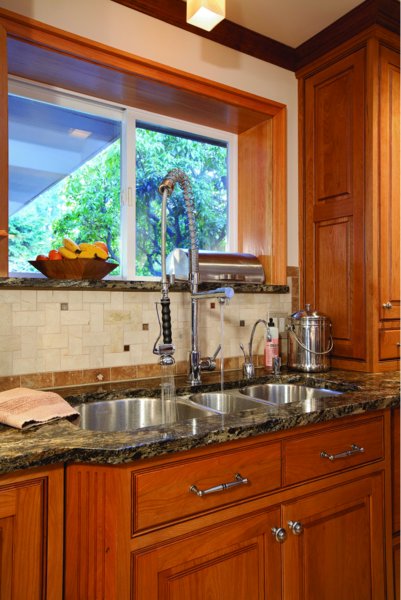
FIGURE 5.8 Pro style faucet at a kitchen sink
Design by Joseph Irons, CGR, GMB, CAPS, CGP and Terence Tung, CKD
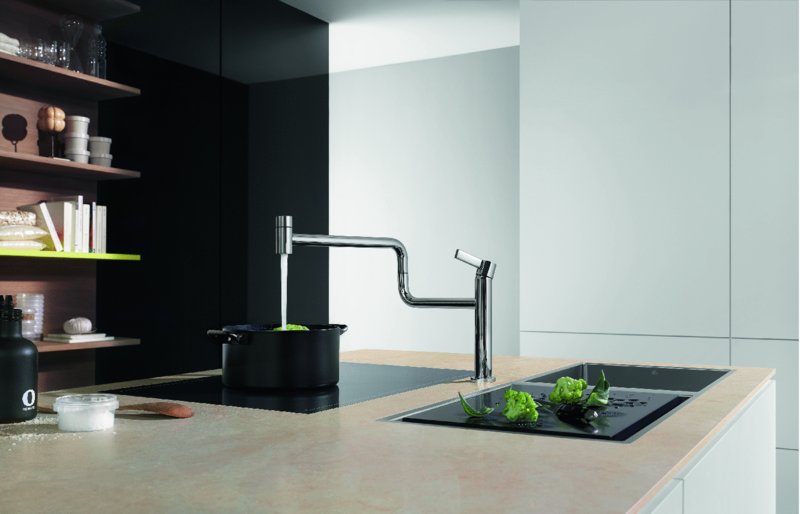
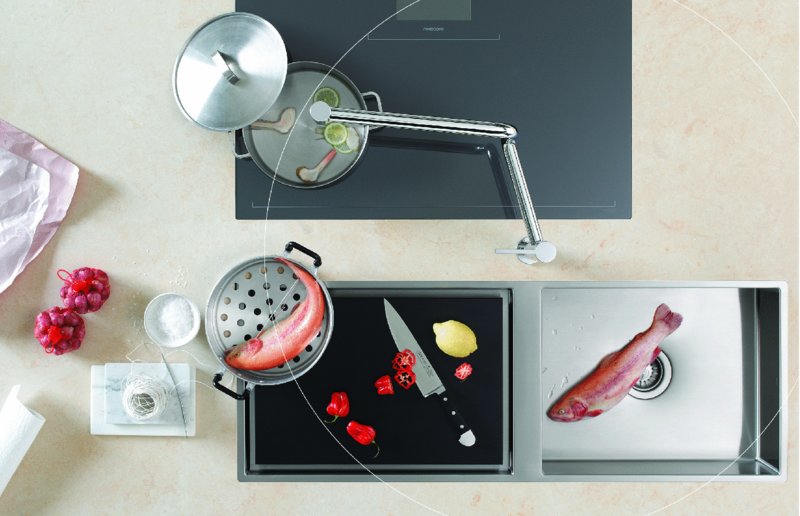
FIGURE 5.9 Pivoting faucet
Courtesy of Dornbracht Americas Inc.
Bathroom Faucet Configurations
As in the kitchen faucet configuration, the bathroom faucet configuration is also determined by both the position and number of controls and the location of the faucet relative to the sink.
Number of holes required by the faucet:
-
Single-hole faucet. Single-handle controls are located above the spout or to the side of the spout. Single-handle bathroom faucets are available with different length spouts (see Figure 5.10). Be sure you specify the proper length for the planned use. Longer spouts are required when used in conjunction with vessel sinks.
The control is turned left or right, pulled up or down, or pushed front to back. These controls sometimes are confusing to individuals not familiar with their operation.
- Two-hole faucet. The water spout occupies one hole; the water volume and temperature controls are separate holes in the countertop.
- Three-hole faucet. The water spout occupies the center hole with a hole to the right of the spout for the cold water faucet and a hole to the left of the spout for the hot water faucet (see Figure 5.11).
- Four-inch center faucet set. Small faucets are available where the spout and two separate handles are mounted on a metal base (called an “escutcheon plate”). Individual holes are concealed by the plate. The drilling is generally 4 inches on center for this type of faucet. Although this is generally an economical faucet, because the handles are very close to the spout, it may be difficult to clean. Unless it has lever handles, some people may find it difficult to use.
- 8- to 12-inch faucet set (commonly called widespread faucet set). Some decorative faucets eliminate the escutcheon plate and separately mount the spout and two handles. The spacing is flexible and may be anywhere from 8 to 12 inches. These faucets are easier to use and care for than 4-inch center faucet sets.
Location of faucet (behind the sink):
-
Wall mounted. These faucets are mounted on the wall behind a sink (see Figures 5.12 and 5.13). Wall-mounted faucets need to be carefully located so that they are properly placed above the bathroom sink and have a spout length specified so the water is deposited in the center of the bathroom sink. Note: Exact wall-mount faucet location and correct matching of faucet spout length and water trajectory is critical when specifying a wall-mounted faucet behind a vessel sink.
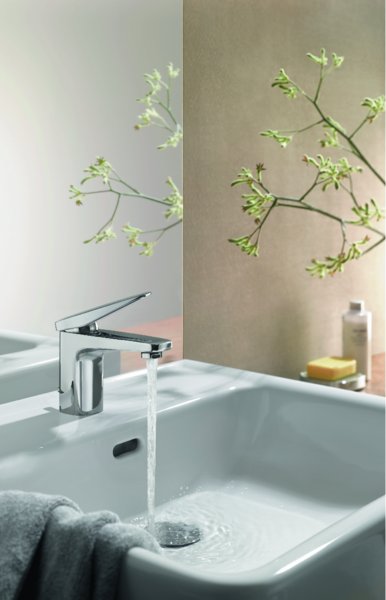
FIGURE 5.10 One-hole faucet
Courtesy of Dornbracht Americas Inc.
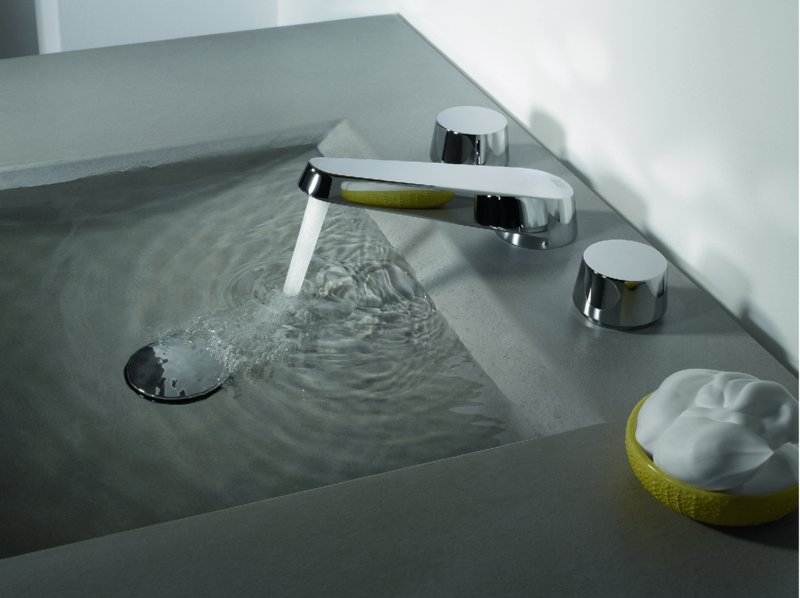
FIGURE 5.11 Three-hole vanity faucet
Courtesy of Dornbracht Americas Inc.
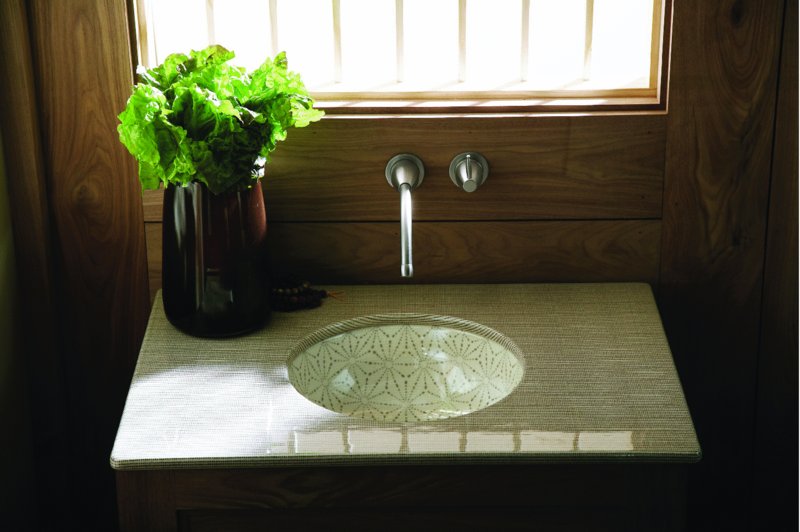
FIGURE 5.12 Single-handle wall-mounted bathroom faucet
Courtesy of Kohler Co.
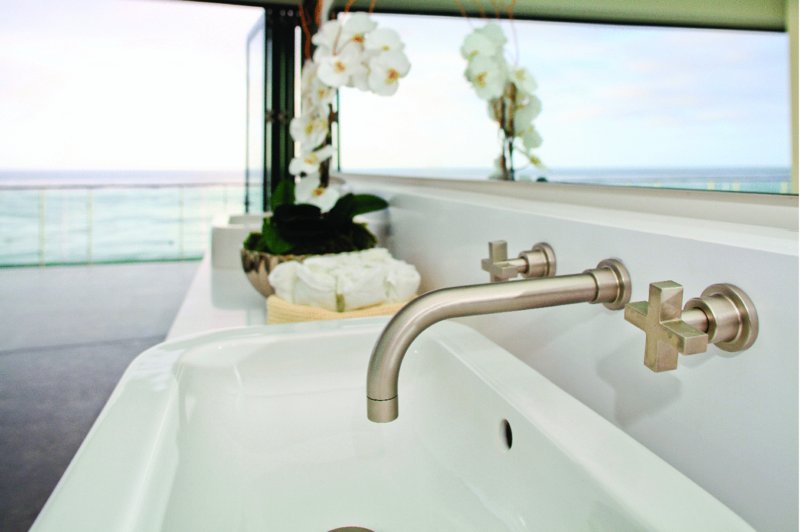
FIGURE 5.13 Double-handle wall-mounted bathroom faucet
Courtesy of ROHL
Kitchen and Bathroom Sink Attachments
In addition to the sink having a variety of accessories available (detailed in Chapter 4), there are special attachments and/or enhancements available for the faucet.
Spout Shapes
The shape of the spout also affects the functionality of the sink. A gooseneck spout has a high arc and is ideally suited for a family that cooks in quantity.
Standard spouts are generally available in 10-, 12-, and 14-inch lengths. Longer spouts are needed for corner sinks, or if you are installing integral sinks in a countertop in a custom arrangement and separating them a bit farther than is the norm.
Spray Attachments
Special-purpose kitchen sink and bathroom lavatory faucets are available that include a separate spray attachment. A separate spray is connected to the water line underneath the sink.
Drinking Fountain
Several manufacturers offer a spout that can be turned so it is comfortable to use as a drinking fountain. This might be an ideal faucet design for a family where bathroom users wake up during the night for a drink of water. It is also a useful feature to use when brushing one’s teeth.
Also on the market today are cold water taps, which are ideal for drinking water taps at secondary locations. These systems can be connected to a filtration system if your client has requested one.
Hot Water Dispenser
This accessory has a faucet that is connected to a small storage tank mounted below the sink. The tank is connected to the cold water supply line and a 120-volt household current. The dispenser tank stores enough hot water for instant coffee, soups, or tea, eliminating the need to heat water in the microwave or boil water at the range top.
Lotion/Soap Dispenser
Installed on the sink ledge or in a countertop, these units have a plastic bottle below the sink and a pump handle above the deck. Hand lotion or liquid soap can be conveniently available at the sink without unsightly bottles or jars sitting on the countertop.
Aerator
Most faucets include an aerator at the end of the spout that mixes air with water to minimize splash-back. When a project is finished, it is not uncommon for the client to complain that the water volume is not as high as it should be. Advise the client to unscrew the aerator and remove the sediment from the screen on a regular basis.
Air Gap
Many codes require a dishwasher to have an air gap installed at the sink to prevent any backup of water in the dishwasher. The air gap is a metal or plastic cap that sits on the sink and is connected to a hose that leads to the dishwasher. A second hose leads to the knock-out on the side of the food waste disposer.
The dishwasher drains through the tubing below the air gap. There are small openings on the air gap, so an overflow will drain into the sink. Warn the client not to be surprised if there is a gurgling sound in the sink as the dishwasher drains in the new kitchen that has an air gap.
The food waste disposer should be cleared after every use because the dishwasher will drain through the disposer.
Bathroom Lavatories
The lavatory drain fitting consists of a brass or plastic waste outlet into which a sliding metal or plastic stopper is fitted. A lever that passes out the side of the drain fitting is connected to a lift rod on top of the lavatory faucet. This rod is lifted to lower the stopper and allow the lavatory to be filled. It is depressed to raise the stopper and drain the lavatory. The stopper should be removed and cleaned periodically to make sure it does not become coated with soap film and/or other debris. Alternatively, a decorative push-and-turn drain fitting can be used on vessel sinks; this fitting may be connected to the water-delivering faucet.
Shutoff (Angle Stop) Valve
Hot and cold water is supplied through supply lines controlled by shut-off valves that are typically in the cabinetry below the kitchen or bathroom sink. In a bathroom featuring a pedestal sink, these supply lines, and the shut-off valves attached to them, are exposed; they are on either side of the pedestal base. Therefore, these plumbing lines must be finished to match the decorative fittings in the bathroom. This is easy to do if polished chrome is the featured finish. Other finishes may not be readily available in the required plumbing piping and valves.
Water Treatment System
In some areas of the country, it may be important for you to be familiar with water purification systems. The water quality of a home can be improved as it enters the house, or it can be improved at a point of use within the house (one of the faucets).
The issue of water quality and what equipment is recommended at the sink is covered in the Kitchen & Bath Residential Construction & Systems volume of the NKBA Professional Resource Library.
There are three broad categories of systems you should be familiar with. One includes installing a filter on the cold water line that leads to a faucet. The second focuses on mounting a filter on the faucet itself. The third method mounts a filter on the line that diverts cold water to a separate faucet.
The first two methods do not affect the overall equipment at the sink, but the last option does require a third and separate faucet. Make sure you know what type of equipment may need to be installed inside the sink cabinet—it may affect a tilt-down drawer head front, a pull-out towel bar, or a lower rollout shelf you are planning. Also, find out what electrical requirements and/or plumbing connections you need to specify.
Helpful Hints from the Pros
Positioning the sink holes. Locate faucet holes along the ledge of an under-mounted sink carefully; they need to clear the sink rim edge. For top-mounted sinks, lay out the hole drilling carefully, with the faucet on site. Check hole spacing if using a two-handle faucet to ensure clearance.
Overall depth of countertops. Make sure you have enough room behind the sink for some of the oversize pro-style, more elaborate faucets. Faucets with controls behind the spout are particularly problematic and might be better placed diagonally to the side of the sink.
Extra-thick countertops. Special planning may be needed for oversize, thick countertops: The shank length of the faucet needs to accommodate the counter thickness.
Oversize sinks. If the faucet does not have a pull-down spray or a side spray, verify that the spout swivel has a wide enough arc to reach all the sink bowls. Two-handle faucets—including bridge-style faucets—may not work with some double-bowl sinks.
SUMMARY
This chapter included an overview of the fittings specified for residential kitchens and bathrooms. The information focused on core construction materials as well as finish options. We also included an extensive discussion about the configuration of kitchen and bathroom faucets and the operational attachments.
In addition to this technical information, planning considerations from practicing professionals are included. Such planning information is helpful to designers when specifying a fitting system that may include a variety of component parts.
The material also focused on safety and comfort, with a discussion about fitting technology that provides volume and temperature control for the user.
REVIEW QUESTIONS
-
Compare the durability attributes of brass versus plastic as a faucet construction material. (See “Construction Materials” pages 194 –195)
-
What is the difference between finishing a bathroom faucet in brushed nickel versus stainless steel? (See “Fitting Finishing Options” page 196)
-
Define the difference between a bridge kitchen faucet, a single-hole kitchen faucet, and a wall-mounted kitchen faucet. (See “Kitchen Faucet Configurations” pages 201–202)
-
Explain the difference between a kitchen pot filler faucet and a gooseneck kitchen faucet with a pull-down spray. (See “Kitchen Faucet Configurations” pages 202–204)
-
Explain the difference between an aerator and an air gap attachment. (See “Kitchen and Bathroom Attachments” page 209.)
-
Explain the difference between a bathroom 4-inch center set and a bathroom 12-inch widespread faucet. (See “Bathroom Faucet Configurations” pages 206–207)
-
Identify the comfort range of hot water for typical human beings in both Fahrenheit and centigrade. (See “Water Control Considerations” page 201)
-
Describe how a valve provides temperature or thermostatic control. (See “Thermostatic Water Temperature Controls” page 201)